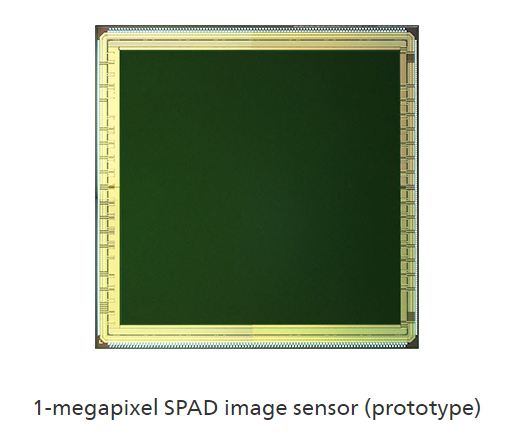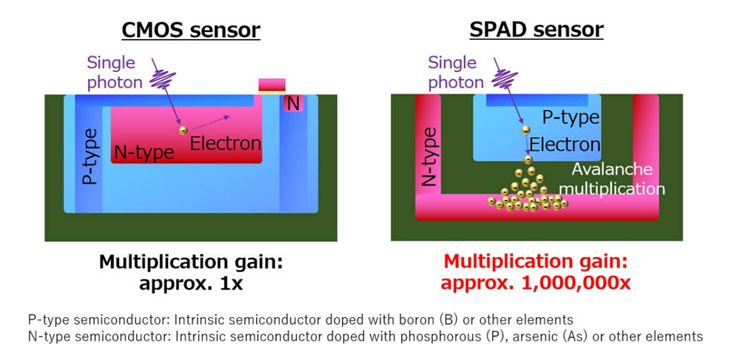Canon developed a single-photon avalanche diode (SPAD) image sensor with signal-amplifying pixels. So, you have to understand the SPAD sensors are already there, Canon upscaled the entire SPAD sensor technology by introducing Signal Amplifying Pixels (capable of capturing 1-megapixel images as of now in its sample prototype).
Advantages of Upscaling the SPAD ( single-photon avalanche diode) Sensor tech with SAP (signal-amplifying ) Pixels.
1. Canon researchers created one of the smallest SPAD pixels ever devised and reduced the power consumption of each pixel to less than 1 μW
2. The new camera can acquire images at up to 24,000 frames per second. For comparison, 30 frames per second is the standard rate used to record video for television.
3. Each SPAD sensor can be finely controlled to allow light in for as little as 3.8 ns. This quick “shutter speed” can capture extremely fast motion or be used to increase the dynamic range of an acquired image.
Moral of the story – The new camera can capture images in faint light at unprecedented speeds.
Single-photon avalanche diode concept isn’t new the avalanche photodiode (APD) was invented by Japanese engineer Jun-ichi Nishizawa in 1952. The First-gen of SPAD CMOS sensor was developed back in 1970.
SPAD Sensor is already being used
Companies like ST Microelectronics, Canon, Sony, Tower Semiconductor (formerly Tower Jazz), Phillips, Micro Photon Devices (MPD), AMS, IDQuantique, and Laser Components offer CMOS SPADs for Automotive industry commercially from a past few years.
In recent years, SPAD sensors have been used in various existing devices and equipment. Currently, smartphones utilize proximity sensors to determine the distance between the device and physical objects around it. In the field of medicine, these sensors are also used to detect radiation for the purpose of detecting cancer in early stages, such as Positron Emission Tomography (PET).
There are high expectations for the application of SPAD sensors in an even wider range of technologies, including onboard vehicle sensors, “xR” type devices–augmented reality (AR), mixed reality (MR), virtual reality (VR), robotic vision and monitoring, space exploration, bio-imaging, optical communications, and quantum computing.
At the end, A large format camera can be created by building an array of pixels that each contain a SPAD.
Now Back to the press release + Canon develops world’s first 1-megapixel SPAD image sensor
Canon SPAD Sensor Press Release
TOKYO, June 24, 2020—Canon Inc. announced today that the company has developed the world’s first1 single photon avalanche diode (SPAD) image sensor with signal-amplifying pixels capable of capturing 1-megapixel images. SPAD image sensors are ideal for such applications as 2-dimensional cameras, which capture and develop still image and video in an extremely short span of time. These sensors also hold potential for use in 3-dimensional cameras due to their ability to obtain information about the distance between them and a subject as image data.

A SPAD sensor is a uniquely designed image sensor in which each pixel possesses an electronic element. When a single light particle, called a photon, reaches a pixel it is multiplied—as if creating an “avalanche”—that results in a single large electrical pulse. The ability to generate multiple electrons from a single photon provides such advantages as greater sensitivity during image capture and high precision distance measurement.
The SPAD image sensor developed by Canon overcomes the longstanding difficulties of achieving this effect with high pixel counts. By adopting new circuit technology, Canon’s sensor uses a method known as photon counting to realize a digital image resolution of 1 megapixel. What’s more, the sensor employs a global shutter that allows simultaneous control of exposure for every pixel. Exposure time can be shortened to as little as 3.8 nanoseconds2, making possible clear and distortion-free image capture. In addition, the sensor is capable of up to 24,000 frames per second (FPS) with 1 bit output, thus enabling slow-motion capture of fast movement within an extremely short time frame.
Thanks to its ability to capture fine details for the entirety of events and phenomena, this technology holds the potential for use in a wide variety of fields and applications including clear, safe and durable analysis of chemical reactions, natural phenomena including lightning strikes, falling objects, damage upon impact and other events that can’t be observed with precision by the naked eye.
The sensor also features a high time resolution as precise as 100 picoseconds2, enabling it to determine the exact timing at which a photon reaches a pixel with ultra-high accuracy. Leveraging this functionality, the sensor is capable of Time of Flight distance measurement. What’s more, with a high resolution of 1 megapixel and high-speed image capture, it is also able to accurately perform 3D distance measurements in situations where multiple subjects overlap—useful in such scenarios as a vehicle distance measurement for self-driving automobiles and grasping 3D spatial information for xR3 and similar devices.
Canon’s development of a SPAD image sensor enables 3D cameras capable of recognizing depth information to achieve a resolution of 1 megapixel is expected to rapidly expand the use of such cameras as the “eyes” of high-performance robotic devices. Going forward, Canon will strive to anticipate the needs of industry by continuing to advance its innovative image sensor technology, further expand the possibilities of what is visible, spur evolution in science and industry through high-precision detection of information and contribute to the development of fields yet to be discovered.
1Among SPAD sensors. As of June 23, 2020. Based on Canon research.
21 nanosecond = one billionth of a second. 1 picosecond = 1 trillionth of a second.
3″xReality,” where x represents a variable for the unknown. Includes AR (augmented reality), MR (mixed reality) and VR (virtual reality).
Additional information
The camera utilizing the sensor described in this press release, and its accompanying journal article, were jointly developed and written with scientists at the Swiss Federal Institute of Technology in Lausanne and published in Optica, the journal of the Optical Society of America.

SPAD Sensors
A Single Photon Avalanche Diode (SPAD) sensor is a specially configured sensor in which a diode is placed within each pixel. Each diode, when receiving a single incoming photon of light, is able to turn this photon into an “avalanche” of electrons to create a single large electrical pulse signal. With the ability to convert a single photon into multiple electrons, this technology can contribute to greater sensitivity during photography as well as more accurate distance measurements.






